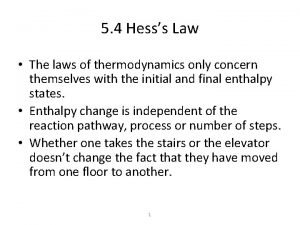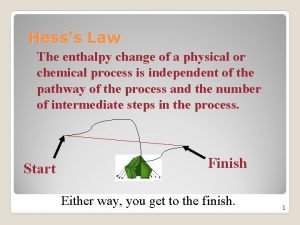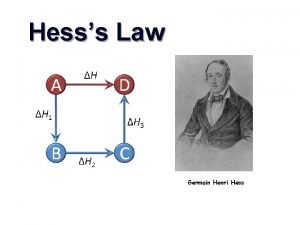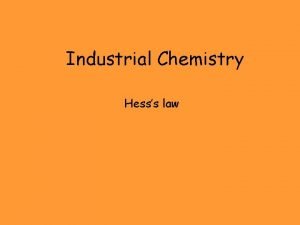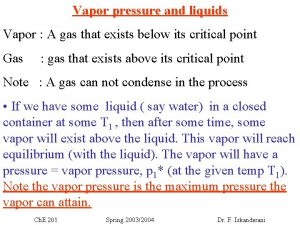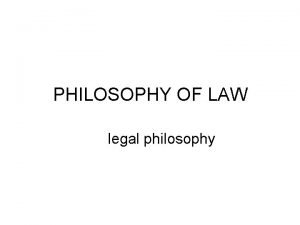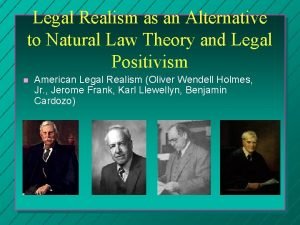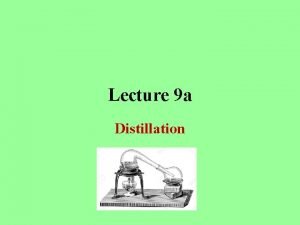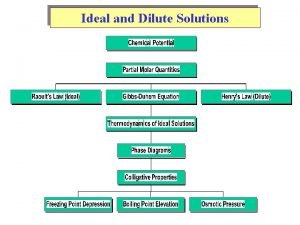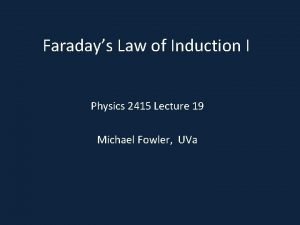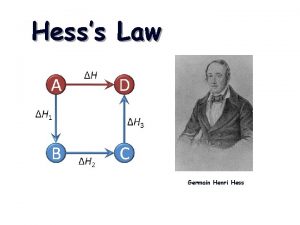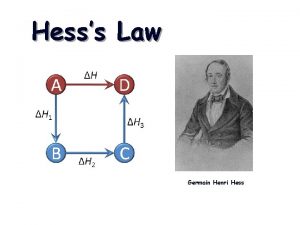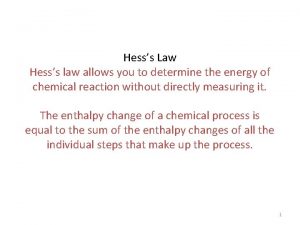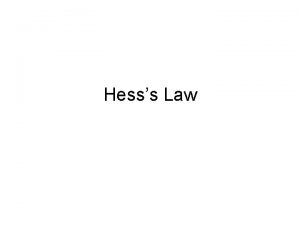TOPIC 5 ENERGETICSTHERMOCHEMISTRY 5 2 HESSS LAW ESSENTIAL























- Slides: 23

TOPIC 5 ENERGETICS/THERMOCHEMISTRY 5. 2 HESS’S LAW

ESSENTIAL IDEA In chemical transformations energy can neither be created nor destroyed (the first law of thermodynamics). NATURE OF SCIENCE (2. 4) Hypotheses – based on the conservation of energy and atomic theory, scientists can test the hypothesis that if the same products are formed from the same initial reactants then the energy change should be the same regardless of the number of steps.

INTERNATIONALMINDEDNESS Recycling of materials is often an effective means of reducing the environmental impact of production, but varies in its efficiency in energy terms in different countries.

THEORY OF KNOWLEDGE Hess’s Law is an example of the application of the Conservation of Energy. What are the challenges and limitations of applying general principles to specific instances?

UNDERSTANDING/KEY IDEA 5. 2. A The enthalpy change for a reaction that is carried out in a series of steps is equal to the sum of the enthalpy changes for the individual steps.

APPLICATION/SKILLS Be able to apply Hess’s law to calculate enthalpy changes.

APPLICATION/SKILLS Be able to determine the enthalpy change of a reaction that is the sum of multiple reactions with known enthalpy changes.

• Hess’s law states that the enthalpy change for any chemical reaction is independent of the route, provided the starting conditions and final conditions, and reactants and products, are the same.

• Hess’s Law is designed so that you will manipulate a series of reactions (called step equations) to reach the required reaction which is most always given. 1. If you reverse a reaction, reverse the sign of ΔH. 2. If you multiply or divide a step equation by an integer, you must also multiply or divide your ΔH by the same factor.

• Hess’s law is a statement of the Law of Conservation of Energy. • It is used to measure enthalpy changes which cannot be measured directly in the laboratory.

• The standard enthalpy of formation (ΔHfº ) is defined as the change in enthalpy that accompanies the formation of one mole of a compound from its elements with all substances in their standard states. • The degree symbol means that the process was carried out under standard conditions.

Example Problem • Consider the standard enthalpy of formation of methane. C(s) + 2 H 2(g) CH 4(g) • Notice that one mole of methane was formed from its elements in their standard states. • This looks like a simple enough equation where we could react carbon with hydrogen to form methane and determine the heat change.

• However, it is difficult to react carbon with hydrogen and practically impossible to do so experimentally. • We can easily burn carbon, hydrogen and methane to determine the standard enthalpy of combustion ΔHcº directly for each of the three substances. • This would give us our step equations with enthalpy values that we could manipulate to determine the ΔH for the ΔHfº for methane.

• C(s) + O 2(g) CO 2(g) ΔHcº = -393 k. J mol-1 • H 2(g) + 1/2 O 2(g) H 2 O(l) ΔHcº = -286 k. J mol-1 • CH 4(g) + 2 O 2(g) CO 2(g) + 2 H 2 O(l) ΔHcº = -890 k. J mol-1 • The main equation again is C(s) + 2 H 2(g) CH 4(g) • I need CH 4 on the right and 2 – H 2’s on the left. • I will have to reverse the 3 rd equation so I change the sign of ΔH. • I will have to double the 2 nd equation because I need 2 H 2’s in the final equation so I will multiply the ΔH by 2.

• C(s) + O 2(g) CO 2(g) ΔHcº = -393 k. J mol-1 • 2 H 2(g) + 2/2 O 2(g) 2 H 2 O(l) ΔHcº = 2(-286) k. J mol-1 • CO 2(g) + 2 H 2 O(l) CH 4(g) + 2 O 2(g) ΔHcº = +890 k. J mol-1 • Now cross out anything that is the same on both sides. • C(s) + O 2(g) CO 2(g) ΔHcº = -393 k. J mol-1 • 2 H 2(g) + 2/2 O 2(g) 2 H 2 O(l) ΔHcº = 2(-286) k. J mol-1 • CO 2(g) + 2 H 2 O(l) CH 4(g) + 2 O 2(g) ΔHcº = +890 k. J mol-1 • Adding the equations will now give us the main equation. • C(s) + 2 H 2(g) CH 4(g) • ΔHfº = +890 k. J mol-1 + 2(-286) k. J mol-1 + -393 k. J mol-1 = -75 k. J mol-1

APPLICATION/SKILLS Be able to calculate the ΔH reactions using ΔHf◦ data.

GUIDANCE Enthalpy of formation data can be found in the data booklet in section 12.

GUIDANCE Be able to use the following equation: ΔH reaction = Σ(ΔHf ◦products) - Σ(ΔHf ◦reactants)

Calculating ΔHf ⁰ ΔHf⁰ = ∑nΔHf ⁰(products) - ∑nΔHf ⁰(reactants) • • You can calculate the standard heat of reaction (ΔH⁰) for any reaction using the above equation. You will be given values in a table, plug them into the above equation and multiply these values by the number of moles in the equation. Then solve.

• The standard enthalpy of formation (ΔHf⁰) for an element is zero. • There is no chemical change and so no enthalpy change when an element is formed from itself.

Sample Problem • Calculate the enthalpy change for the following reaction given the standard enthalpy changes of formation. • C 3 H 8(g) + 5 O 2(g) 3 CO 2(g) + 4 H 2 O(l) ⁰ of C H -1 ΔH = -104 k. J mol f 3 8(g) • • ΔHf⁰ of CO 2(g) = -394 k. J mol-1 • ΔHf⁰ of H 2 O(l) = -286 k. J mol-1

• C 3 H 8(g) + 5 O 2(g) • -104 0 3 CO 2(g) + 4 H 2 O(l) 3(-394) 4(-286) • • ΔHf⁰ = ∑nΔHf ⁰(products) - ∑nΔHf ⁰(reactants) • • = [3(-394) + 4(-286)] – [(-104) + (0)] = -2220 k. J mol-1

Citations International Baccalaureate Organization. Chemistry Guide, First assessment 2016. Updated 2015. Brown, Catrin, and Mike Ford. Higher Level Chemistry. 2 nd ed. N. p. : Pearson Baccalaureate, 2014. Print. Most of the information found in this power point comes directly from this textbook. The power point has been made to directly complement the Higher Level Chemistry textbook by Catrin and Brown and is used for direct instructional purposes only.
 Hess's law rules
Hess's law rules Hesss law
Hesss law Hess's law example
Hess's law example Hesss
Hesss Essential non essential fatty acids
Essential non essential fatty acids Clincher in writing
Clincher in writing Research problem example for students
Research problem example for students Newton's first law and second law and third law
Newton's first law and second law and third law Si unit of newton's first law
Si unit of newton's first law Boyle's law charles law avogadro's law
Boyle's law charles law avogadro's law P=k/v
P=k/v Raoult's law and dalton's law
Raoult's law and dalton's law Difference between civil law and criminal law
Difference between civil law and criminal law Programl
Programl Principles of natural law
Principles of natural law Natural law vs positive law
Natural law vs positive law Law of segregation vs law of independent assortment
Law of segregation vs law of independent assortment 4-7 the law of sines and the law of cosines
4-7 the law of sines and the law of cosines Positive law vs natural law
Positive law vs natural law Distillation vs steam distillation
Distillation vs steam distillation Criminal law plaintiff
Criminal law plaintiff Raoult's law and dalton's law
Raoult's law and dalton's law Mendel data
Mendel data Emf law
Emf law
